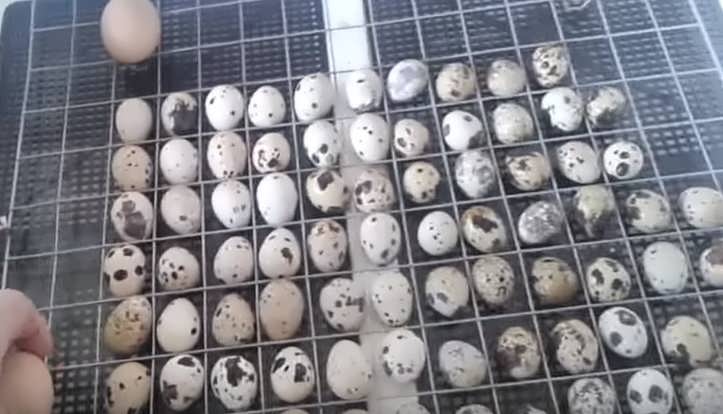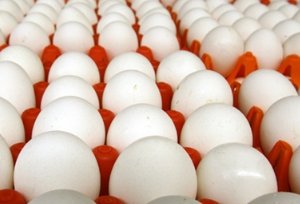The mode of breeding turkeys in an incubator is different from other breeds of birds. The artificial method of reproduction requires the farmer to comply with the rules.
- The process of selecting and preparing eggs before laying them in an incubator .
- After bookmarking, it is important to turn over . Moreover, turkey eggs need to be turned more often than eggs of other breeds of birds.
- It is required to strictly observe the temperature regime.
Turkey egg incubation mode
The average yield of turkeys in the incubator is 75% of the eggs laid. Such an indicator is possible if the eggs were stored before laying for no more than 10 days under the following conditions:
- temperature not higher than 120C;
- humidity - 80%.
The yield of turkeys may be higher if the eggs were stored for no more than 5 days. The number of chicks decreases if the storage period is two weeks or more. If the shelf life is more than 25 days, the eggs are not suitable for incubation.
Preparation before bookmark and bookmark
Eggs for incubation are subjected to a thorough inspection. Eggs suitable for hatching:
- obtained from turkeys over eight months of age;
- the shell should be clean, but not washed;
- the surface of the shell is smooth, without flaws.
Before laying, be sure to carry out candling of turkey eggs . The ovoscope lamp allows you to identify defects. Eggs are suitable for laying, in which:
- the yolk moves smoothly in the protein;
- the location of the air chamber on the blunt side;
- the protein should be homogeneous without blood streaks or inclusions;
- turning the egg over, under the lamp it should be visible how the yolk slowly moves back to its original position.
The following are subject to culling:
- with two yolks;
- round shape - they do not have enough protein;
- when the yolk is close to the air chamber;
- in cases where the yolk, after rotation, does not return to its original position.
Candling helps to remove specimens unsuitable for incubation
Preparation of the incubator before laying:
- 24 hours before laying eggs, the incubator is disinfected;
- pour clean, unfiltered water into the water tank;
- the incubator heated 12 hours before laying.
- 24 hours before laying, the eggs are kept in a room so that they warm up to room temperature, since cold laying is not allowed.
- Before laying, they are disinfected with a cloth soaked in a solution of hydrogen peroxide, potassium permanganate or glutex.
- Two marks are made on each egg, which will not allow you to make a mistake while turning over.
Cleaning of dirt should be carried out carefully so as not to disturb the protective layer. Some farmers recommend disinfection by dipping eggs in a solution, while others advise wiping them lightly.
Loading of an incubator is made taking into account type of the device.
- If the incubator is provided with automatic turning, the eggs are laid vertically. The sharp end should be at the bottom, the slope angle is 450.
- If mechanical or manual turning is provided, laying in a horizontal position is carried out.
Incubation process
The first turning is done 12 hours after laying. The procedure is required to be carried out every 3 hours for 24 days. That is, 8-12 turns are made per day. The same interval between turns should be observed. Night turning is allowed once with a break of 6 hours.
To prevent overheating and to maintain humidity, masonry should be sprayed. Airing and spraying is carried out:
- on the first day it is not advisable to ventilate;
- twice the day before the twelfth day;
To check how the incubation stages go, breeders use an ovoscope.
- By the eighth day, the incubation of the first stage is completed. During this period, a developed circulatory system is visible in the egg. The embryo is not visible yet. A live embryo is distinguished by a light spot in the yolk. A dark spot indicates a dead embryo. This instance should be deleted.
- The second transillumination is carried out on the 13th day. During this period, the contour of the embryo is visible.
- By day 26, the embryo occupies the entire space. The embryo actively sticks out its neck, but if no movements are noticeable, then the embryo is dead.
Incubation table
How to breed turkeys in an incubator? For convenience, it is better to use the temperature and humidity control table. Incubation temperature and ventilation time at home different incubation periods are not the same.
| Day | Temperature | Ventilation |
| 1 to 5 | Z8 0 C | closed |
| 6 to 12 | Z8 0 C | 10 min |
| From 13 - 25 | Z8 0 C | 15 minutes |
| 26 | 37,50C | 20 minutes |
| 27 | 37,50C | damper open |
| 28 | 370C | damper open |
We recommend a useful article about what diseases turkeys can suffer from and how to treat them properly . the care and feeding of turkey poults at home will also be useful .
During incubation periods, you will need to monitor the humidity in the incubator.
| Incubation | Humidity |
| First 8 days | 65% |
| From 9 to 14 days | 50% |
| 15 – 25 days | 65% |
| 26 - 28 days | No need to moisturize |
The process of turning, airing and spraying is completed on the 25th day. When the first pecks appear, it is required to set the temperature in the incubator to 370C, the humidity index to 65%. The incubation time ends on the 28th day with the appearance of chicks.
Breeding turkeys in an incubator at home
An incubator at home allows you to hatch chicks at any time. This process differs from the hatching of chickens in a longer period.
After how many days do turkeys appear? The timing depends on the type of cross:
| View | Beginning of hatching in days | The appearance of the first chicks in a day | Mass appearance of turkeys | End of incubation |
| Easy cross | 25; 12 hours delay allowed | 26 + 12 hours | Day 27 | 27 days, a delay of 12 hours is possible |
| heavy cross | 25 with a possible delay of 12 hours | 26 + 8 hours | 27 days and possibly + 12 hours | After 28 days. |
It is required to pay attention to the selection and proper preparation of material for incubation. After laying, it is necessary to control the indicators of temperature, humidity, and to produce ventilation.
The control process depends on the model of the incubator. There are household appliances, the design of which provides for:
- automatic egg turning;
- there are humidity sensors;
- temperature sensors.
The most common mistakes when breeding turkeys in an incubator
Breeding turkey poults in an incubator is not difficult. It is only required to follow the recommendations for the withdrawal of young animals. Any violation of the regime can provoke the death of the brood.
- In order for turkey poults to be healthy, overheating should not be allowed. When overheated, the chicks begin to hatch ahead of schedule and it is highly likely that they will have defects.
- At low temperatures, the chicks appear late. Usually this is a weak brood.
- At low humidity, the mass of eggs decreases. Chicks hatch early. At the same time, it is difficult for them to get out through the hardened shell and they themselves hatch dry.
- With high humidity, hatching of the chicks is delayed, they look dirty, and many can choke in the amniotic fluid.
- If the frequency of turning was lowered, the chick may dry out to the shell. Usually these embryos do not survive.
We advise you to familiarize yourself: Turkey poults began to fall to their feet, what to do .
Useful video on the topic









I failed to grow turkeys for the first time, because I made some mistakes. But now I don't do them and I'm happy with the result.